
Callisto, or Jupiter IV, is the second-largest moon of Jupiter, after Ganymede. In the Solar System it is the third-largest moon after Ganymede and Saturn's largest moon Titan, and as large as the smallest planet Mercury, though only about a third as massive. Callisto is, with a diameter of 4,821 km, roughly a third larger than Earth's Moon and orbits Jupiter on average at a distance of 1,883,000 km, which is about six times further out than the Moon orbiting Earth. It is the outermost of the four large Galilean moons of Jupiter, which were discovered in 1610 with one of the first telescopes, being visible from Earth with common binoculars.
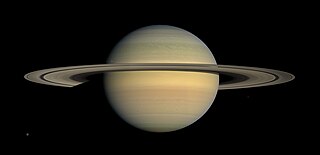
Saturn is the sixth planet from the Sun and the second-largest in the Solar System, after Jupiter. It is a gas giant with an average radius of about nine-and-a-half times that of Earth. It has only one-eighth the average density of Earth, but is over 95 times more massive. Even though Saturn is nearly the size of Jupiter, Saturn has less than one-third of Jupiter's mass. Saturn orbits the Sun at a distance of 9.59 AU (1,434 million km) with an orbital period of 29.45 years.

Titan is the largest moon of Saturn and the second-largest in the Solar System. It is the only moon known to have an atmosphere denser than the Earth's, and is the only known object in space other than Earth on which clear evidence of stable bodies of surface liquid has been found. Titan is one of the seven gravitationally rounded moons of Saturn and the second-most distant among them. Frequently described as a planet-like moon, Titan is 50% larger than Earth's Moon and 80% more massive. It is the second-largest moon in the Solar System after Jupiter's moon Ganymede, and is larger than Mercury, but only 40% as massive due to Mercury being made of mostly dense iron and rock, while a large portion of Titan is made of less-dense ice.

Rhea is the second-largest moon of Saturn and the ninth-largest moon in the Solar System, with a surface area that is comparable to the area of Australia. It is the smallest body in the Solar System for which precise measurements have confirmed a shape consistent with hydrostatic equilibrium. It was discovered in 1672 by Giovanni Domenico Cassini.

Cassini–Huygens, commonly called Cassini, was a space-research mission by NASA, the European Space Agency (ESA), and the Italian Space Agency (ASI) to send a space probe to study the planet Saturn and its system, including its rings and natural satellites. The Flagship-class robotic spacecraft comprised both NASA's Cassini space probe and ESA's Huygens lander, which landed on Saturn's largest moon, Titan. Cassini was the fourth space probe to visit Saturn and the first to enter its orbit, where it stayed from 2004 to 2017. The two craft took their names from the astronomers Giovanni Cassini and Christiaan Huygens.

Tethys, or Saturn III, is the fifth-largest moon of Saturn, measuring about 1,060 km (660 mi) across. It was discovered by Giovanni Domenico Cassini in 1684, and is named after the titan Tethys of Greek mythology.

Iapetus is the outermost of Saturn's large moons. With an estimated diameter of 1,469 km (913 mi), it is the third-largest moon of Saturn and the eleventh-largest in the Solar System. Named after the Titan Iapetus, the moon was discovered in 1671 by Giovanni Domenico Cassini.

Dione, also designated Saturn IV, is the fourth-largest moon of Saturn. With a mean diameter of 1,123 km and a density of about 1.48 g/cm3, Dione is composed of an icy mantle and crust overlying a silicate rocky core, with rock and water ice roughly equal in mass. Its trailing hemisphere is marked by large cliffs and scarps called chasmata; the trailing hemisphere is also significantly darker compared to the leading hemisphere.

Enceladus is the sixth-largest moon of Saturn and the 19th-largest in the Solar System. It is about 500 kilometers in diameter, about a tenth of that of Saturn's largest moon, Titan. It is mostly covered by fresh, clean ice, making it one of the most reflective bodies of the Solar System. Consequently, its surface temperature at noon reaches only −198 °C, far colder than a light-absorbing body would be. Despite its small size, Enceladus has a wide variety of surface features, ranging from old, heavily cratered regions to young, tectonically deformed terrain.

Mimas, also designated Saturn I, is the seventh-largest natural satellite of Saturn. With a mean diameter of 396.4 kilometres or 246.3 miles, Mimas is the smallest astronomical body known to be roughly rounded in shape due to its own gravity. Mimas's low density, 1.15 g/cm3, indicates that it is composed mostly of water ice with only a small amount of rock, and study of Mimas's motion suggests that it may have a liquid ocean beneath its surface ice. The surface of Mimas is heavily cratered and shows little signs of recent geological activity. A notable feature of Mimas's surface is Herschel, one of the largest craters relative to the size of the parent body in the Solar System. Herschel measures 139 kilometres across, about one-third of Mimas's mean diameter, and formed from an extremely energetic impact event. The crater's name is derived from the discoverer of Mimas, William Herschel, in 1789. The moon's presence has created one of the largest 'gaps' in Saturn's ring, named the Cassini Division, due to orbital resonance destabilizing the particles' orbit there.
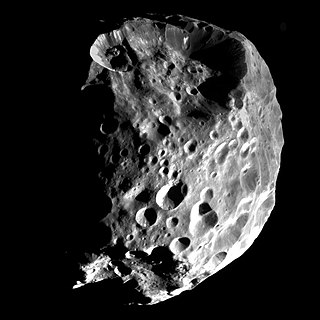
Phoebe is the most massive irregular satellite of Saturn with a mean diameter of 213 km (132 mi). It was discovered by William Henry Pickering on 18 March 1899 from photographic plates that had been taken by DeLisle Stewart starting on 16 August 1898 at the Boyden Station of the Carmen Alto Observatory near Arequipa, Peru. It was the first natural satellite to be discovered photographically.

This article provides a timeline of the Cassini–Huygens mission. Cassini was a collaboration between the United States' NASA, the European Space Agency ("ESA"), and the Italian Space Agency ("ASI") to send a probe to study the Saturnian system, including the planet, its rings, and its natural satellites. The Flagship-class uncrewed robotic spacecraft comprised both NASA's Cassini probe, and ESA's Huygens lander which was designed to land on Saturn's largest moon, Titan. Cassini was the fourth space probe to visit Saturn and the first to enter its orbit. The craft were named after astronomers Giovanni Cassini and Christiaan Huygens.

The moons of Saturn are numerous and diverse, ranging from tiny moonlets only tens of meters across to the enormous Titan, which is larger than the planet Mercury. There are 146 moons with confirmed orbits, the most of any planet in the solar system. This number does not include the many thousands of moonlets embedded within Saturn's dense rings, nor hundreds of possible kilometer-sized distant moons that were seen through telescopes but not recaptured. Seven Saturnian moons are large enough to have collapsed into a relaxed, ellipsoidal shape, though only one or two of those, Titan and possibly Rhea, are currently in hydrostatic equilibrium. Three moons are particularly notable. Titan is the second-largest moon in the Solar System, with a nitrogen-rich Earth-like atmosphere and a landscape featuring river networks and hydrocarbon lakes. Enceladus emits jets of ice from its south-polar region and is covered in a deep layer of snow. Iapetus has contrasting black and white hemispheres as well as an extensive ridge of equatorial mountains among the tallest in the solar system.

The rings of Saturn are the most extensive and complex ring system of any planet in the Solar System. They consist of countless small particles, ranging in size from micrometers to meters, that orbit around Saturn. The ring particles are made almost entirely of water ice, with a trace component of rocky material. There is still no consensus as to their mechanism of formation. Although theoretical models indicated that the rings were likely to have formed early in the Solar System's history, newer data from Cassini suggested they formed relatively late.

Shikoku Facula is a region of bright material on Saturn's moon Titan.
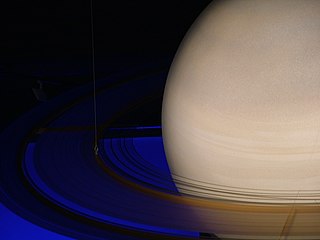
The exploration of Saturn has been solely performed by crewless probes. Three missions were flybys, which formed an extended foundation of knowledge about the system. The Cassini–Huygens spacecraft, launched in 1997, was in orbit from 2004 to 2017.

Lakes of liquid ethane and methane exist on the surface of Titan, Saturn's largest moon. This was confirmed by the Cassini–Huygens space probe, as had been suspected since the 1980s. The large bodies of liquid are known as maria (seas) and the small ones as lacūs (lakes).

Lofn is a large relatively young impact crater on Jupiter's Galilean satellite Callisto. It was identified in 1997 and named after the goddess of marriage in Norse mythology. Located near the south pole of this moon, Lofn is classified as a flat floored or anomalous dome impact crater. It is superimposed on Adlinda multilayer structure obscuring about 30 percent of it. Another multi-ring structure—Heimdall is found to the south-west of Lofn.
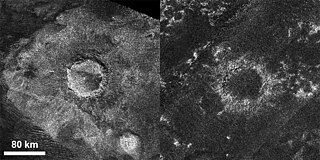
Sinlap is a shallow impact crater on Titan, a natural satellite of Saturn. Located in the Fensal region, Sinlap is one of the most pristine craters on Titan, surrounded by a bright ejecta blanket.
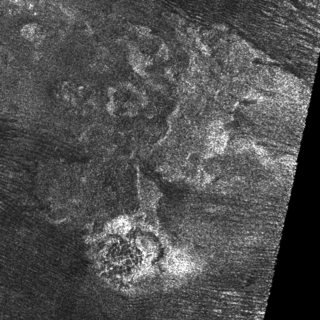
Doom Mons is the name of a mountain range and its eponymous peak on Titan, the largest moon of Saturn. A putative cryovolcano, it is the largest mountain range on Titan by volume. It was discovered by the Cassini–Huygens probe in 2005 and officially named in 2012.





















